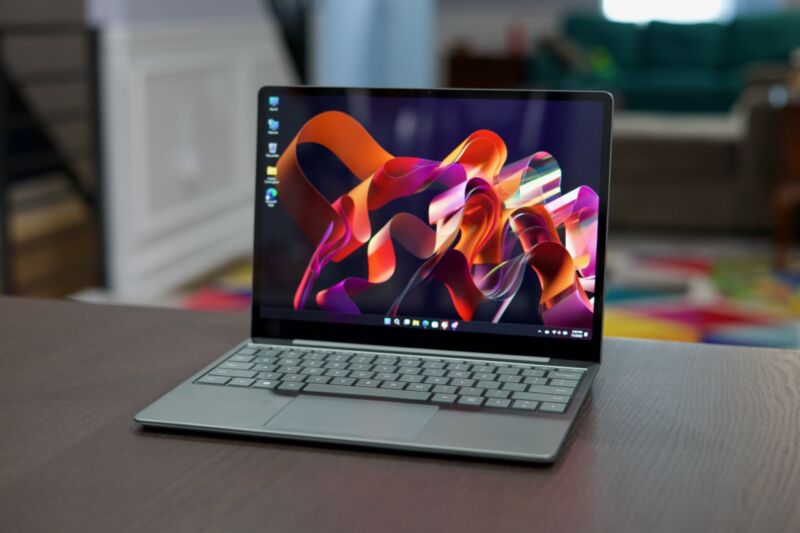
Anyone who buys a Microsoft Surface Laptop Go 2 should go into it fully aware of the laptop's shortcomings.
The first and most important is that the base model, the one that gives it its attractive $600 starting price, comes with only 4GB of non-upgradeable RAM and should be ignored by pretty much everybody. Seriously, don't buy it, and don't try to talk yourself into it just to save money.
Behave as though the actual starting price is $700, the amount it costs to get the configuration with 8GB of RAM and 128GB of storage. This is still closer to "budget" than "high-end" as ultrabooks go, but the list of omissions, shortcomings, and odd decisions does get harder to overlook as you spend more money. The generation-old processor. The un-backlit keyboard. The tiny port selection. A touchscreen that is neither particularly high-resolution nor very colorful. A 128GB SSD that will feel cramped for many people, and a 256GB option that (1) isn't all that much bigger and (2) adds another $100 to the price.
None of these problems should be glossed over or ignored. But as frustrating as some of them are, the fact remains that the Laptop Go 2 is a cute, lightweight, competent laptop that's a pleasure to use. Microsoft gets most of the important things right here, and there's no laptop in this price range that doesn't come with some kind of trade-off.
Especially if you can find it on sale—and the old Laptop Go was discounted regularly by Microsoft, Best Buy, and others that sold it—the Laptop Go 2 is a no-fuss budget laptop that's worth considering if you can live with its flaws.
Thoughtful design, minimalist features

| Specs at a glance: Microsoft Surface Laptop Go 2 | |
|---|---|
| Screen | 12.4-inch 1536×1024 touchscreen (148 PPI) |
| OS | Windows 11 Home |
| CPU | 4-core/8-thread Intel Core i5-1135G7 |
| RAM | 4GB or 8GB LPDDR4x |
| GPU | Intel Iris Xe graphics (80 EUs) |
| Storage | 128GB or 256GB NVMe SSD |
| Battery | 41 WHr |
| Networking | Wi-Fi 6 (802.11ax), Bluetooth 5.1 |
| Ports | USB-A, USB Type-C, Surface Connect, 3.5 mm headphone |
| Size | 10.95×8.12×0.62 inches (278.2×206.2×15.7 mm) |
| Weight | 2.48 lbs (1.12kg) |
| Warranty | 1-year |
| Price as reviewed | $799.99 |
| Other perks | 720p webcam, power button-mounted fingerprint reader in 8GB models |
Externally, the Surface Laptop Go 2 is indistinguishable from the original. Microsoft hasn't changed the keyboard, trackpad, screen, or chassis at all, opting merely to replace the internals. The only external difference is the addition of a color called "Sage," a vaguely green-tinted silver finish that complements the returning pink-tinted Sandstone, blue-tinted Ice Blue, and non-tinted Platinum options. It weighs less than 2.5 pounds, and it's super easy to pick up and carry around, whether you're slinging it in a bag to travel or just moving between rooms in your home.
If you're not familiar with the original Laptop Go, here's a brief recap: The laptop has a lightweight aluminum lid and palm rest, combined with a plastic bottom cover. The combination is lightweight and reasonably sturdy-feeling, even though the thin aluminum feels a bit more pliable than what you get with a MacBook, a Dell XPS, or Microsoft's own higher-end Surface and Surface Laptop devices. The trackpad is on the small side, but it's accurate and responsive. And while the keyboard lacks a backlight, its key spacing and travel both feel pleasant, and its power button-mounted fingerprint sensor is a welcome addition.
The laptop's biggest point of departure from other laptops in this price range is a 12.5-inch 1536×1024 screen with a 3:2 aspect ratio, making it narrower but much taller than the 16:9 or 16:10 screens in most ultrabooks. The screen's 376-nit peak brightness, 1,159:1 contrast ratio, and color gamut coverage (94 percent of the sRGB gamut, just 68.5 percent of the DCI-P3 gamut) are all just fine for the price.
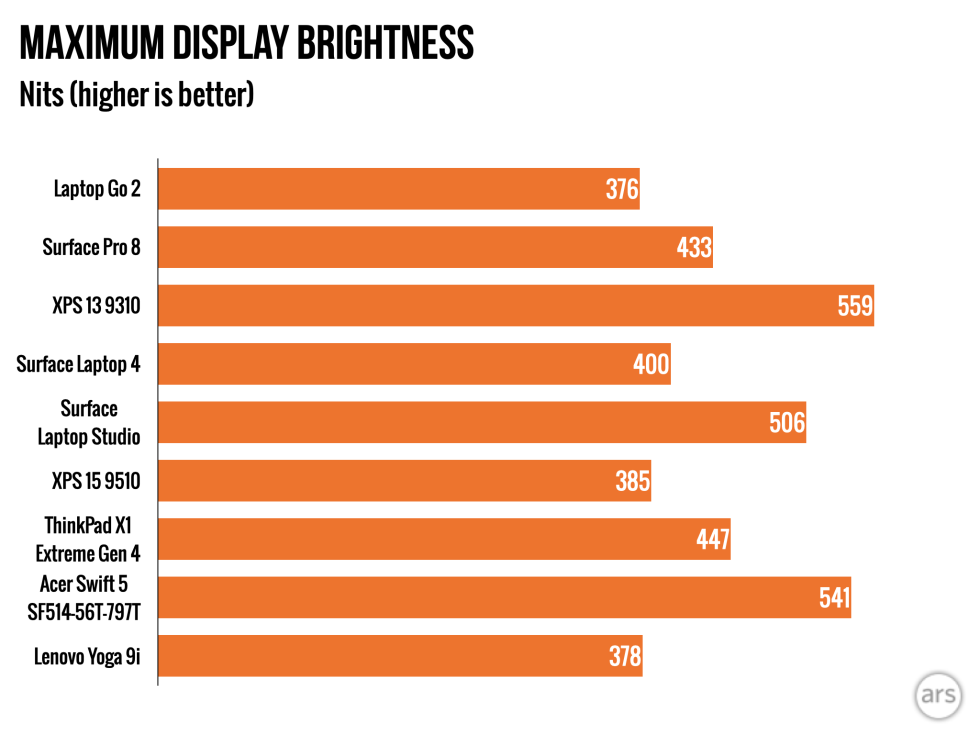
But the display isn't as dense as a more typical 13.3-inch 1080p or 1920×1200 screen (about 149 PPI, down from the mid-to-high 160s), which makes text look a bit jaggy by comparison, especially at smaller sizes and lighter weights. But the screen's size and aspect ratio are great for a laptop this small and light. If you happen to be replacing an older 11.6-inch 16:9 netbook-y budget laptop with the Laptop Go 2, the difference is night and day.
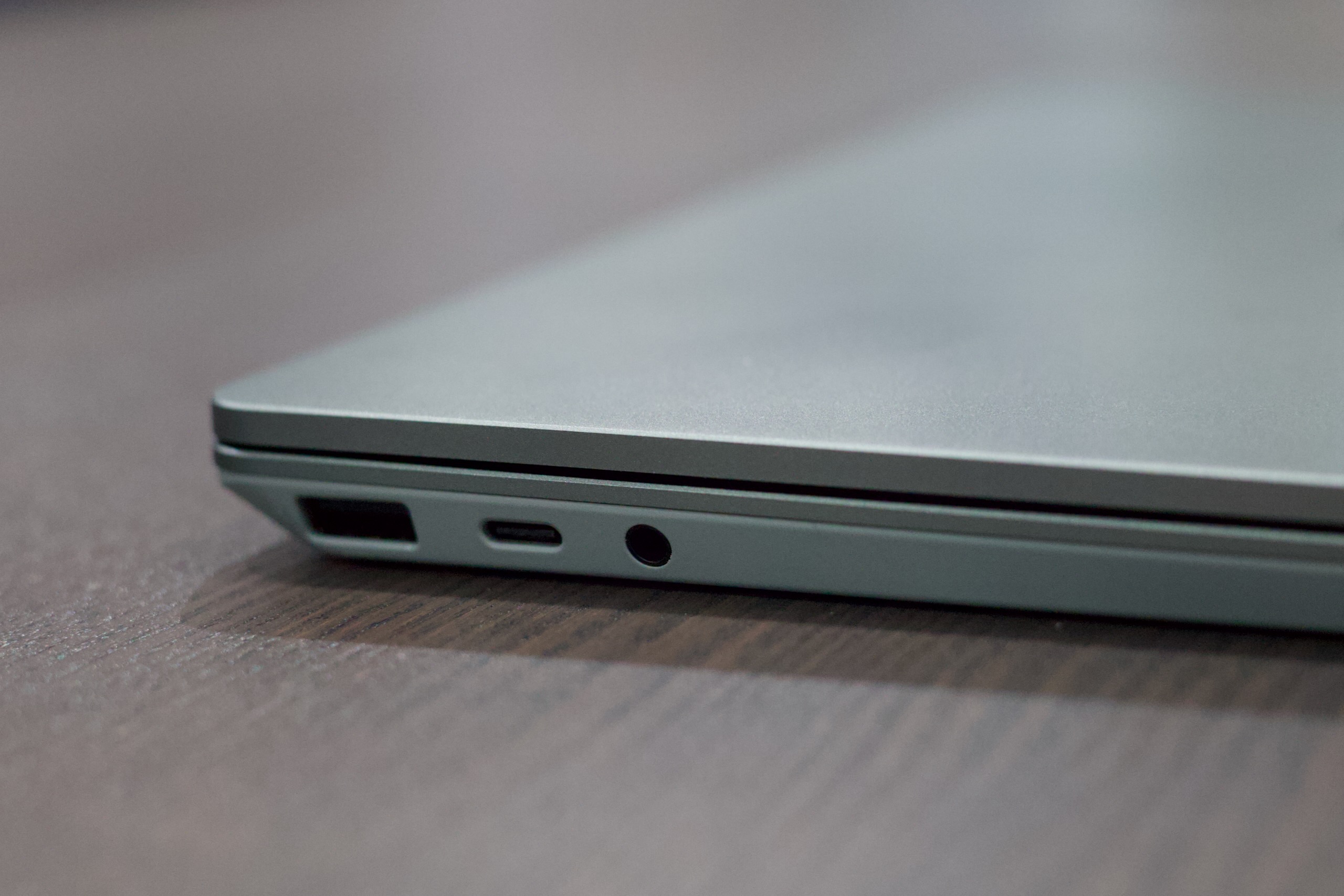 Almost all of the Surface Laptop Go 2's ports are on the left side: one USB-A, one USB-C (which can charge the laptop but isn't the primary charging port), and a headphone jack.Andrew Cunningham
Almost all of the Surface Laptop Go 2's ports are on the left side: one USB-A, one USB-C (which can charge the laptop but isn't the primary charging port), and a headphone jack.Andrew Cunningham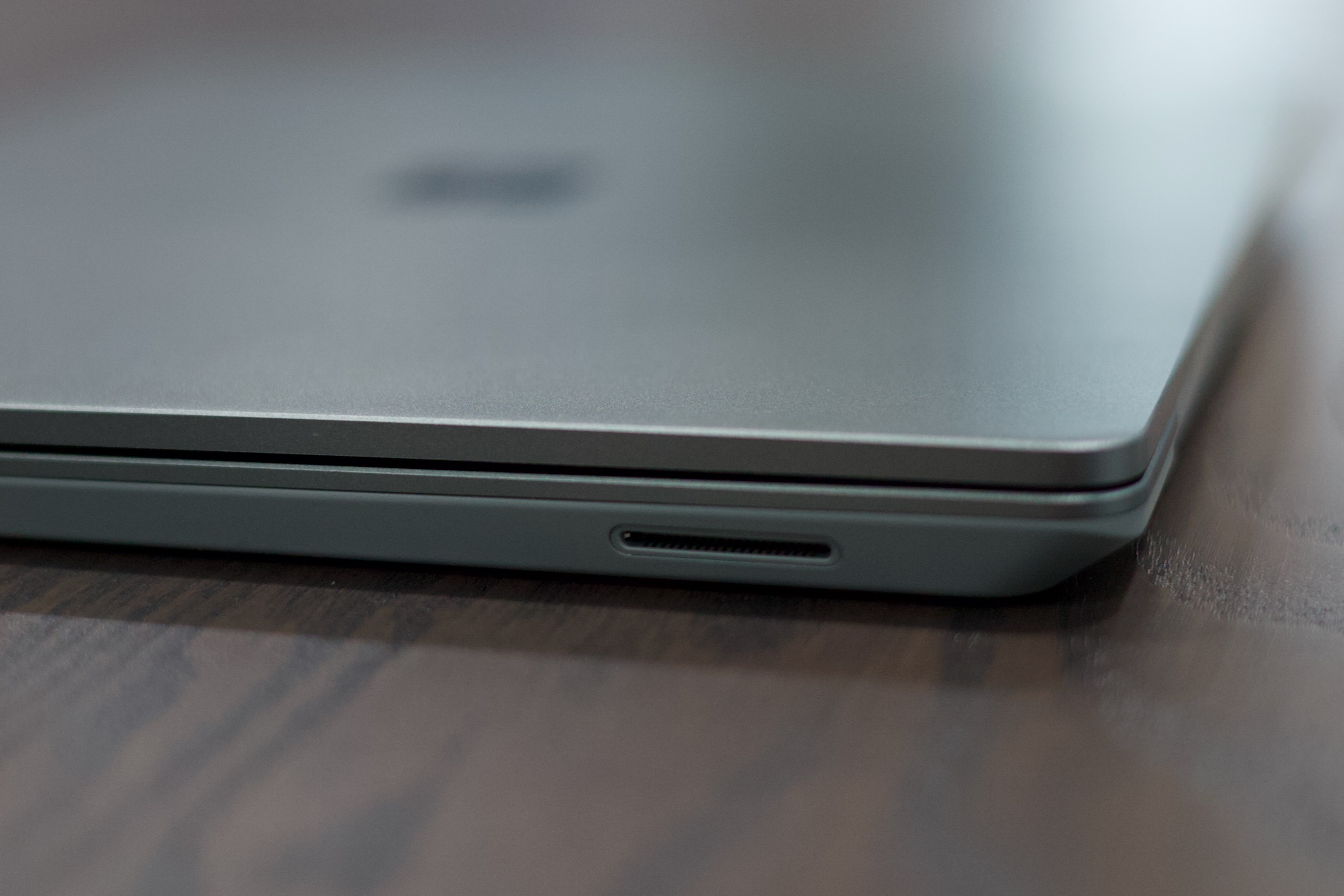 The only port on the other side is the proprietary Surface Connect port.Andrew Cunningham
The only port on the other side is the proprietary Surface Connect port.Andrew Cunningham
It's harder to like the Laptop Go 2's port selection, though it shares this shortcoming with the bigger Surface Laptop. You get a single USB-A port, a single USB-C port, a headphone jack, and the proprietary Surface Connect port—and that's it. It's nice to be able to charge the laptop without blocking either USB port, and it's handy to be able to charge via the USB-C port if you need or prefer to. It's just a bare-minimum selection of ports, and we'd trade Surface Connect for another USB-C port any day.
And while it doesn't really make a difference in the day-to-day use of the device, there's something to be said for getting some of the fringe benefits of Surface ownership in a less-expensive laptop. There are a lot of Windows devices out there that can't pull down UEFI firmware updates or other hardware/firmware-level security features seamlessly through Windows Update, and most budget devices are lucky to get many of these kinds of updates at all. To its credit, Microsoft keeps budget-focused devices like the Surface Go or Surface Laptop Go updated regularly.
Performance and battery
Microsoft is at best a late adopter of new CPUs in its flagship products, and in its budget PCs, the company seems content to save money by staying at least a CPU generation behind the rest of the industry. As a money-saving tactic, it could be worse—I'd certainly take a 2- or 3-year-old Core i5 over a new Atom CPU or an N-series Celeron or Pentium. But it does mean settling for an older 11th-generation Core i5-1135G7 CPU rather than more powerful, versatile 12th-gen Core or AMD Ryzen CPUs.
Still, the new CPU is a respectable step up in performance from the 10th-generation Core i5 in the first Laptop Go, especially in graphics performance. The Intel Iris Xe GPU is fast enough to play less-demanding games pretty well on the Laptop Go 2's lowish-resolution panel, whereas the older, slower Intel UHD Graphics GPU wasn't good for much more than connecting an external monitor.
 Andrew Cunningham
Andrew Cunningham Andrew Cunningham
Andrew Cunningham Andrew Cunningham
Andrew Cunningham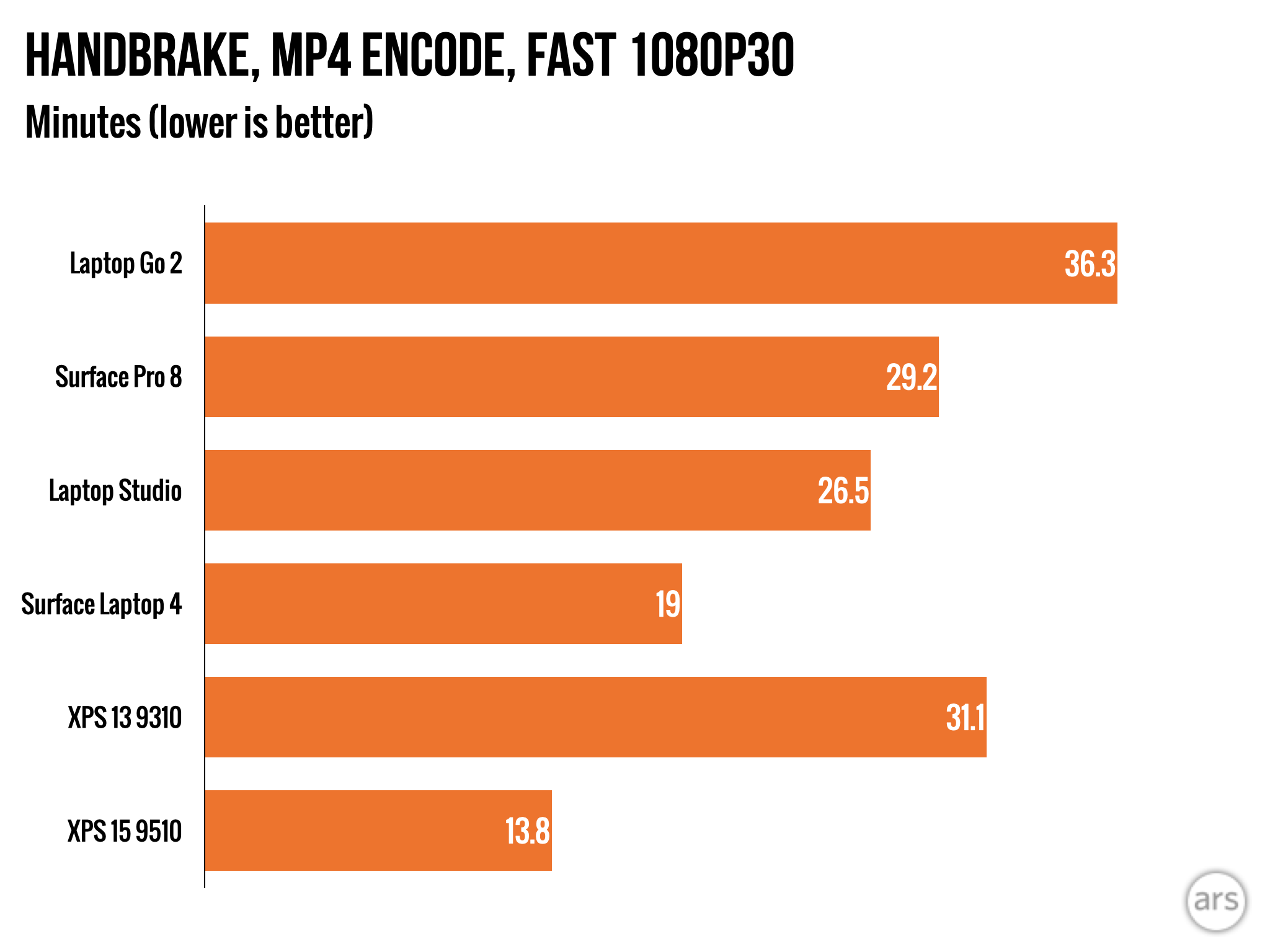 Andrew Cunningham
Andrew Cunningham
The i5-1135G7 is a known quantity, and it will mostly perform the same in the Laptop Go 2 as it does in other laptops with the same chip. You'll see some differences in multithreaded tests or in workloads where the CPU is doing a lot of work for a sustained period of time—see the multi-core Geekbench and Cinebench tests or the Handbrake video encoding test. Compared to the Dell XPS 13 with the same chip, Microsoft has scaled back the amount of power the i5-1135G7 is allowed to use. But people aren't typically buying $700 laptops to do these kinds of things, so we're not inclined to ding the Laptop Go 2 much over this.
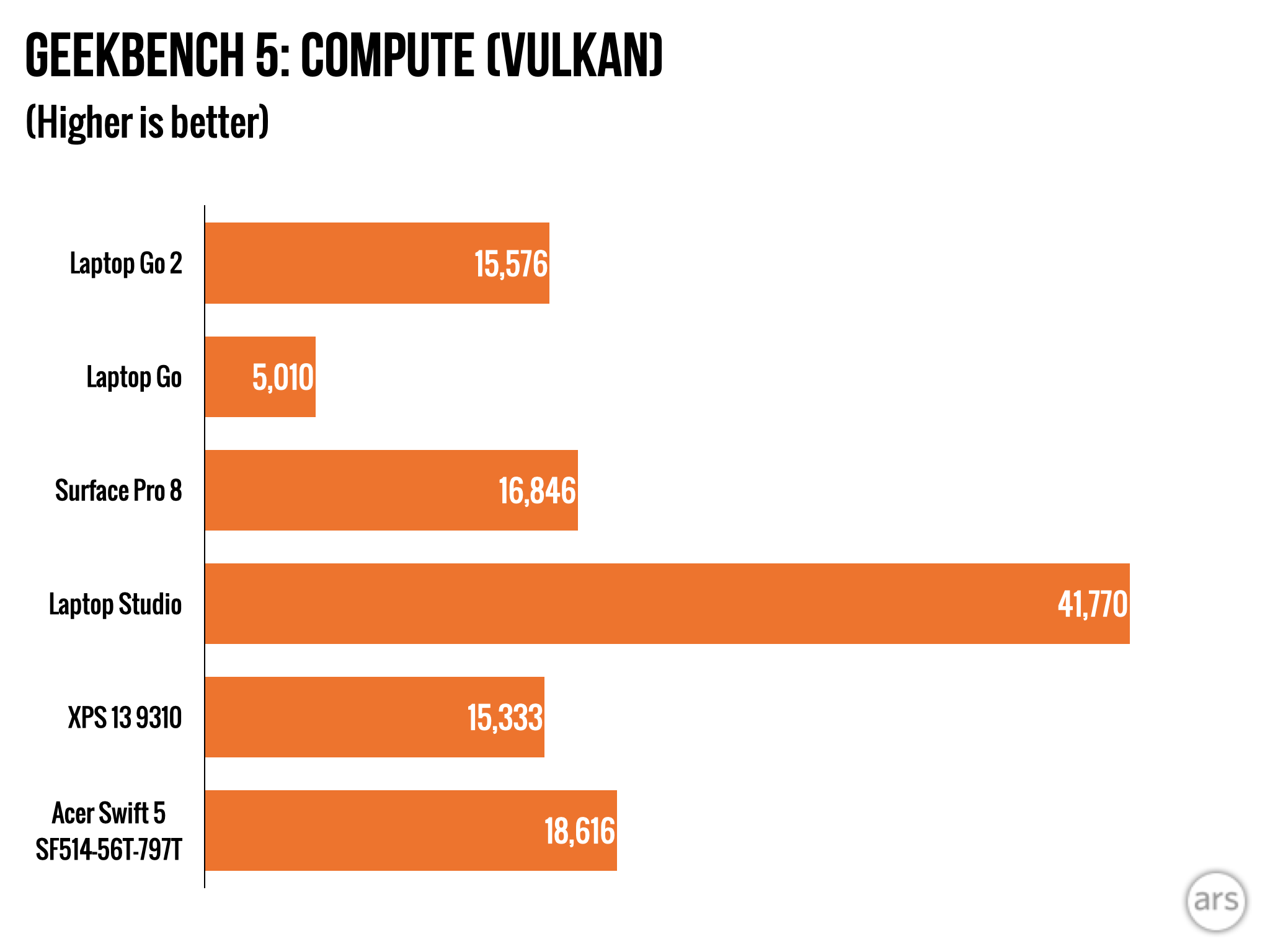 Andrew Cunningham
Andrew Cunningham Andrew Cunningham
Andrew Cunningham
Graphics performance is also similar to (but just a shade lower than) other 11th-gen laptops, which still represents a big upgrade for anyone who was considering the last-gen Laptop Go or those who are moving from an older laptop with Intel's UHD 520 or 620 graphics. High-end AAA games will be out of reach, but the laptop has happily played the likes of Fall Guys, American Truck Simulator, and my beloved Deep Rock Galactic at higher-than-minimum settings.
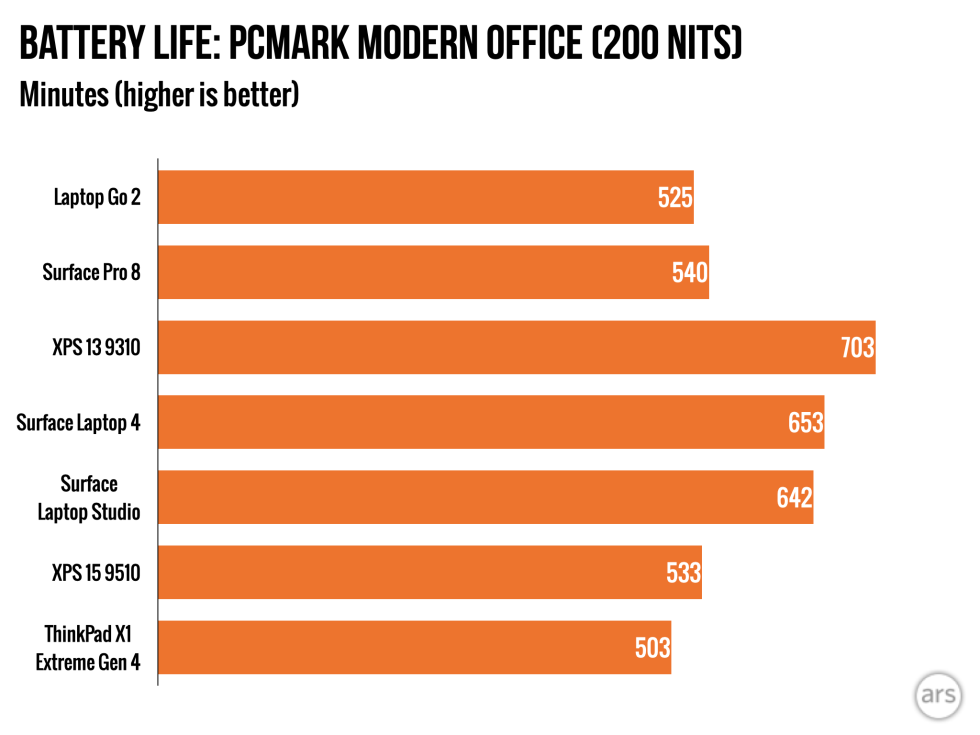
Microsoft rates the Laptop Go 2 for 13.5 hours of battery life, though real-world testing and the PCMark Modern Office battery life test were less rosy. The laptop lasts for around 8.5 hours in the PCMark test, which is only OK these days—enough to get through a day of work or school—but well short of the Surface Laptop 4 or the 11th-gen version of Dell's XPS 13. Regular use backed this up; I could get through a full day of browsing, Slack, and Discord use, but by the time 4 or 5pm rolled around it was ready for a charge.
Repairability
The first few Surface tablet generations were sandwiches of glass, metal, and glue that were nearly impossible for end users to repair or upgrade themselves, but Microsoft has made repairability more of a priority in recent years. Though it looks the same as the last-gen Surface Laptop Go, Microsoft's press release says that the Go 2 includes more user-serviceable parts.
The service manual for the device includes procedures for replacing the rubber feet on the bottom, the top cover (including the keyboard and trackpad), the display and lid assembly, the battery, the SSD, and the "Surflink" port for the proprietary Surface power connector. RAM remains soldered to the motherboard, as it is in many laptops. The Framework Laptop it ain't, but well-illustrated, up-to-date service manuals should be the norm for more laptops.
As in other Surface devices, Microsoft is using a standard-but-rare kind of M.2 SSD in the Laptop Go 2. It uses a typical 22 mm wide M.2 connector but at a short 30 mm length rather than the 80 mm length common in most consumer SSDs. You just won't find many M.2 2230 SSDs from retailers, so upgrading the Laptop Go 2's SSD usually means buying something used or a "new" drive intended to be sold to PC OEMs that is instead being sold by a wholesaler on eBay or Amazon.
For people who are comfortable with it, you can save yourself a fair amount of money by buying the 128GB version of the Laptop Go 2 and installing your own 256GB or 512GB SSD—available on eBay for $25-ish and $50-ish, respectively, as of this writing. 1TB drives are rarer and considerably more expensive, but it's easier to buy them than it was a year or so ago. Microsoft doesn't officially recommend installing third-party SSDs like this, but if you stick to known manufacturers like Samsung, Western Digital, Kioxia, or SK Hynix, you should be fine (the built-in drive in our 256GB review unit is an SK Hynix drive).
A lot to look past, a lot to like

Microsoft Surface Laptop Go 2
If you're focused solely on getting the most performance for your money, $700 can buy you a better laptop than the Surface Laptop Go 2. Look on retailer websites and you'll be able to find AMD Ryzen CPUs with more processor cores, laptops with 16GB of RAM and/or 512GB of storage, and models that have more ports or convertible hinges. Screens with 16:10 aspect ratios are becoming much easier to find, steadily trickling down from high-end ultrabooks. From Acer's Swift 3 series to Asus' VivoBook series to various Dell Inspirons and Lenovo Yogas, most laptop makers have respectable offerings in this price range that are worth considering.
But there is an appeal to the simplicity of the Surface Laptop Go 2. It nails all of the basics, and its clean design is eye-catching. The 3:2 screen is a pleasure to use. The soft-to-the-touch aluminum and plastic finish and the laptop's sub-2.5-pound weight make it a pleasure to hold and carry. There's nothing very exciting about its performance, especially if you find 8GB of RAM limiting, but it's fast enough for normal computer things.
All of this makes the Laptop Go 2 a very easy laptop to like, even if it's not always the best value for the money. As someone who is frequently asked to recommend computers to people, there's definitely value in being able to point to an easy-to-buy, nice-to-use laptop like the Laptop Go 2 and say, "just buy that one." It's definitely better than sifting through ever-shifting retail listings and trying to choose from among dozens of similar offerings from the PC makers.
The good
- More than good enough performance for everyday tasks and even light gaming
- Comfortable keyboard and trackpad
- Super lightweight and pleasant to carry around
- Colorful screen with a tall 3:2 aspect ratio
- No more 64GB storage option
- Great first-party software, driver, and firmware support
- A few nods toward repairability
The bad
- 2-year-old CPU that doesn't perform quite as well as the same chip in other laptops
- No backlit keyboard
- Limited port selection
- Paying for 8GB RAM and 256GB SSD is expensive; each upgrade adds $100 and makes this budget laptop less budget-y
The ugly
- A paltry 4GB of RAM makes the $600 base model impossible to recommend
Review: Microsoft’s Surface Laptop Go 2 has a lot of problems, but I like it anyway - Ars Technica
Read More

No comments:
Post a Comment